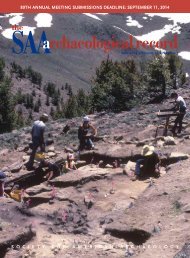SAA
Nov2016_web
Nov2016_web
Create successful ePaper yourself
Turn your PDF publications into a flip-book with our unique Google optimized e-Paper software.
VIDEO IN MEMORIAM GAMES AND ARCHAEOLOGY<br />
ROBERT PORTER POWERS<br />
1952–2016<br />
Robert “Bob” Porter Powers was born in 1952 in Laguna<br />
Beach, California, and passed away January 2, 2016, in<br />
Santa Fe, New Mexico. It was his mother who suggested<br />
that he enter the field of archaeology. As a high school graduate,<br />
Bob was more interested in taking his partly functional<br />
jeep on a trip to South America than a college education. His<br />
mother bargained with him: if he completed a year in archaeology<br />
(she noted his affinity for dirt) at the University of Arizona,<br />
he could take his trip. The trip was<br />
started with two friends, but the vehicle<br />
failed; Bob, however, eventually earned<br />
an M.A. in archaeology.<br />
Bob’s first fieldwork was with the School<br />
of American Research crew excavating<br />
Arroyo Hondo Pueblo. His career with<br />
the National Park Service (NPS) began at<br />
Chaco Canyon National Monument in<br />
1974, where he took part in the excavation<br />
of Pueblo Alto, among other sites,<br />
and later led the Chaco outlier survey. He<br />
is remembered for his commitment to<br />
the Chaco Project, which extended<br />
throughout his career as he authored,<br />
oversaw, or enabled numerous projects<br />
by park service colleagues, students, and<br />
other professionals, including a final<br />
synthesis of Chaco Project contributions.<br />
In the mid-1980s, he began work as project<br />
director on the Bandelier Archaeological<br />
Survey, a five-year, 14,000-acre effort<br />
reported in technical papers, bachelor’s<br />
and master’s theses, and dissertations, and concluded with<br />
the award-winning popular book The Peopling of Bandelier:<br />
New Insights from the Archaeology of the Pajarito Plateau, in collaboration<br />
with the School for Advanced Research and David<br />
Grant Noble. In the late 1990s, Bob returned to school for his<br />
M.A. at the University of New Mexico (2000) and pursued a<br />
doctoral degree there until 2014. His planned dissertation<br />
examined agricultural strategies, population mobility, and village<br />
formation in Bandelier National Monument.<br />
As an archaeologist for the Intermountain Region of the NPS,<br />
Bob also oversaw major inventory projects at Pecos, Natural<br />
Bridges, Bryce Canyon, and El Malpais national monuments<br />
and at Amistad National Recreation Area. The people who<br />
worked with Bob in the field or in the office recall the highfunctioning<br />
teams of people he created, his intellectual and<br />
personal generosity as a manager, and his remarkable work<br />
ethic.<br />
Both as a NPS employee and as a volunteer, Bob was a tireless<br />
advocate for New Mexico archaeology. He worked with the<br />
Bureau of Land Management to protect archaeological sites in<br />
the Galisteo Basin and served on the<br />
Society for American Archaeology’s task<br />
force, working to protect the sites and<br />
traditional cultural properties associated<br />
with the Greater Chaco Landscape.<br />
Bob was a regular at the annual Pecos<br />
Conference and helped organize the<br />
1989 meeting at Bandelier. In 2013, noting<br />
the increasingly gray heads of fellow<br />
attendees, Bob came up with the idea of<br />
offering a prize for the best paper presented<br />
by a young archaeologist. Originally<br />
named in honor of Linda Cordell, a<br />
dear friend of Bob and his wife, Willow,<br />
this year it has been renamed the<br />
Cordell/Powers Prize. In the three years<br />
since its inception, Pecos attendees have<br />
marveled at the dramatic effect Bob’s<br />
idea has had on the quality of papers presented<br />
and at the enthusiastic mob of<br />
young people who now attend.<br />
Bob is survived by his wife, Willow, an<br />
anthropologist and archivist, whom he<br />
met at Chaco Canyon and married in 1985. Their rambling<br />
adobe house in Santa Fe is a testament to Bob’s enormous talent<br />
in every sort of craft; the wide circle of friends entertained<br />
there is a testament to their enjoyment of and curiosity about<br />
the world around them.<br />
Thanks to Willow Roberts Powers, Paul Reed, David Grant<br />
Noble, Jon Sandor, and Signa Larralde.<br />
—Sarah Herr, Desert Archaeology Inc., and Catherine M.<br />
Cameron, University of Colorado, Boulder<br />
38 The <strong>SAA</strong> Archaeological Record • November 2016




